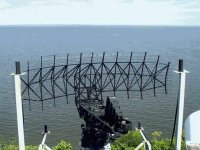John Hutchison & Ronnie
Milione
The Philadelphia Experiment
Recreated!
NAVY RADAR SYSTEMS
AN/SPS-49 Radar
 |
|
The AN/SPS-49 radar is the navy's principal long-range
two-dimensional air search radar. As such it has been used on a variety
of combatants including aircraft carriers, Aegis and non-Aegis cruisers,
destroyers, frigates, and amphibious ships including LSDs and LHDs. Up
to 200 systems have been operational at one time. Originally developed
to provide general air surveillance against aircraft, it also provides
significant detection performance against both high altitude and
sea-skimming missiles due to its high average power, clutter rejection,
anti-jamming, and automatic detection features. |
Several versions of the radar have been produced over the
years including the following major variants:
- SPS-49(V)1 - Developed in the early 1970s.
Included sidelobe cancellation and digital MTI. Video outputs provided to
PPI displays.
- SPS-49(V)5 - Developed in the early 1980s.
Added automatic detection and Doppler processing. Digital outputs provided
to an associated tracker.
- SPS-49A(V)1 - Developed in the mid 1990s.
Added radial speed determination on each target, each scan. Improved clutter
rejection.
Major characteristics common to all versions of the radar
include:
- FREQUENCY 850-942 MHz, three selectable 30MHz bands, 48 discrete
frequencies
- PEAK and AVERAGE POWER 360 kW typical, 280 kW specified peak power; 12
kW average power
- ANTENNA
- Parabolic Reflector: 8 ft X 24 ft, stabilized for roll and pitch
- Gain: 28.5 dB
- Beamwidths: 3.3� az, 11� elev, csc� to 20� elev
- Rotation Rate: 12 or 6 rpm
The Radar Division of the Naval Research Laboratory has
been involved in the SPS-49 program since its inception. Contributions include
participating in specification development, design reviews, factory acceptance
testing, and planning and conducting performance evaluation tests, both
land-based and shipboard. A key feature of the most recent version of the radar,
the SPS-49A(V)1 is single-scan radial velocity estimation of all targets
allowing faster promotion to firm track and improved maneuver detection. This is
done using unique signal processing techniques originated and tested by the
Radar Division of NRL using 6.1 and 6.2 Office of Naval Research (ONR) funds.
The results of this research have been transferred into production.
Specifications
| frequency: |
850 to 942 megahertz's |
| pulse repetition time (PRT): |
280, 800 or 1000 hertz's |
| pulse repetition frequency (PRF): |
120 microseconds |
| pulsewidth (PW): |
|
| receive time: |
|
| dead time: |
|
| peak power: |
280 to 360 kilowatts |
| average power: |
12 to 13 kilowatts |
| displayed range: |
250 nautical miles |
| range resolution: |
0.03 nautical miles |
| beamwidth: |
3.3 degrees |
| hits per scan: |
|
| antenna rotation: |
6 or 12 rpm. |
  |







![]()